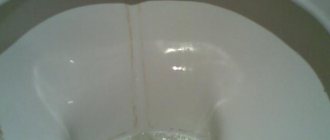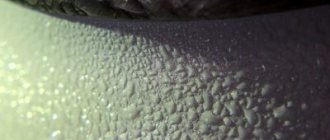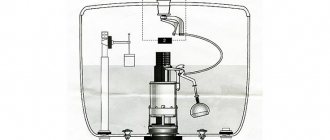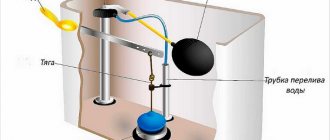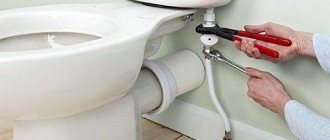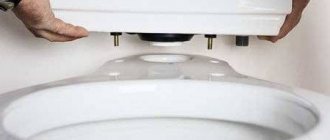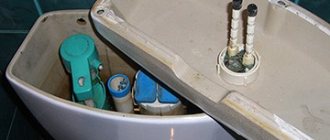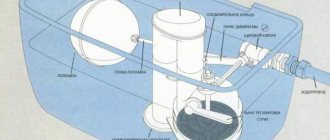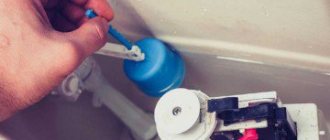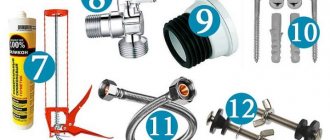Malfunctions of the interior of the toilet and their elimination
If water, even in a thin stream, flows freely into the toilet, then its volume in the tank must be continuously replenished. Hence the droplets of water on the surface and large water bills. The solution to the problem is to eliminate the leak. Sometimes replacing a worn rubber siphon membrane helps:
- drain the water completely from the tank;
- fix the lever in such a position that the hole is closed with a valve and no more water flows in;
- dismantle the siphon by disconnecting it from the lever;
First of all, you should eliminate possible tank leaks, if any.
- remove the worn membrane and replace it with a new one;
- return the siphon to its place and secure it;
- perform a test drain.
The reason may also be hidden in a faulty float, then perform the following actions:
- remove the float from the tank;
- pour water out of it;
- let dry;
Float repair
- seal the hole through which water enters;
- are installed in place.
If it is possible to buy a new float, then this option is better, because... the repaired part will still not last long. The problem can be solved even easier if the leak occurs due to the incorrect position of the float; to eliminate it, simply open the reservoir and return the lever to its normal position.
Ways to fix the problem in an apartment and private house
To solve the problem with condensation, you need to inspect the room and the tank itself. If fogging of the tank in the cold season and the appearance of condensation is not permanent, then you do not need to take additional measures. In this case, the surface of the tank has time to dry before the next visit to the toilet, and does not pose a threat.
Normalization of ventilation
If the cause of condensation is poor ventilation, then the solution is:
- More frequent ventilation.
- Organizing natural air exchange by installing special valves in the door itself leading to the toilet or purchasing a door with a gap of 10-15 mm along the bottom edge.
- Cleaning the ventilation shaft.
- Air dryer installation.
- Installation of an exhaust system in the vent.
Following simple rules will help improve the microclimate:
- after wet cleaning, allow the room to dry thoroughly without closing the door;
- if the bathroom is combined, then do not cover the entire space with wet things after washing, reduce the time for taking water procedures, especially with the formation of steam;
- Finish washing the surfaces by wiping the walls dry.
Thermal insulation of water supply
The water coming through the pipes has a low temperature in winter. This can be done by insulating the supply pipes and insulating the cold water riser into a box.
If the reason is a breakdown
Most often, the reason for the appearance of moisture outside the tank is leaks , leading to the fact that the water gradually leaves, and its missing volume is replenished from the pipeline.
In this case, the liquid does not have time to warm up, and there is always cold water in the tank.
The solution to the problem is to repair the mechanism and replace the gaskets . If the water does not flow out spontaneously, then moisture on the tank itself will either not form at all, or it will become much less.
Insulation of the toilet itself
Insulating the toilet area also helps reduce the amount of condensation. You can insulate the ceiling, walls and floor. For these purposes, only those materials that are suitable for rooms with high humidity should be used.
Tank modernization
Other methods of dealing with moisture on the surface of earthenware are associated with modification of the device itself:
- Insulation of the tank itself from the inside.
- Installation of a new two-layer tank made of plastic and earthenware.
- Upgrading an existing tank by placing another plastic container inside it. It should fit freely inside the earthenware bowl and leave a gap between the containers of at least 2 mm. The role of a seal is played by gaskets made of silicone or rubber.
- Organization of preheating of water entering the tank.
Most of the work associated with upgrading the tank requires special knowledge and experience.
The insulation procedure is carried out with the tank removed and the mechanism removed, on a clean and dry base using isover or other material. The absence of condensation in the future will depend on the quality of thermal insulation work. In this case, the insulation is installed using sealant.
If polyurethane foam was used as insulation on the inside of the tank, it can be trimmed and leveled only after it has completely dried. It is convenient to use a stationery knife for these purposes. Despite its functionality, such insulation does not look presentable and is inferior to other means.
Another option is to use a mixture of sealant and glass microspheres used for tuning cars. The prepared product is applied in a thin layer about 3 mm thick. Drying time depends on the specific sealant, this information can be found on the packaging.
The video will show you how to remove condensation on the toilet cistern:
Minimum drain function
Many tanks have two flush buttons . One of them allows you to pour out not all the water from the tank, but only part of it. At the same time, new cold water begins to flow into the container, but there will be less of it than when the tank is completely emptied.
The two-stage flush button will also help save water consumption, especially when using the toilet frequently.
If there is no such function, then the drain can not be completed completely, simply by not pressing the control button all the way, or by adjusting the operation of the valve.
Supplying warm water to the tank
Another non-standard solution to the problem is to supply the tank with warm rather than cold water. This option can be organized in several ways - for example, by hinged switching. The downside of this solution is the increased cost of water consumption to flush the toilet.
Other ways to eliminate condensation
Never a sweaty toilet
Not long ago, toilet models with a two-piece tank appeared on sale. The water in it is in an internal plastic tank and does not come into contact with the walls of the main vessel, therefore, condensation does not form. The solution is ideal, but the cost is confusing - it is several times higher than that of a toilet with a traditional tank.
Construction of a two-piece toilet cistern
Minimizing waste
The smaller the volume of water that goes down the drain, the greater the chance that there will be no condensation. There are toilets with a cistern equipped with a two-button mechanism. When one button is used, approximately 5 liters of water flows out of the tank, the other - about 7 liters. And in tanks with an Aquastop drainage system, one control button is built into the lid: with one press, water begins to pour out, and with a second press you can stop this process.
Two-button mechanism for flushing water
Insulation of the cistern
Some craftsmen independently isolate the walls of the tank from interaction with cold water. The modification is as follows:
- Turn off the water supply.
- Disconnect the hose through which water flows.
- Remove the drain tank.
- Dismantle everything inside the tank.
- Rinse the container and wipe dry.
- Cut out the liner from the insulation. To do this, lay it out on a flat plane, place the tank on it in the same position as it usually stands in the working position, trace the bottom around the perimeter, and then cut out the workpiece. Design of the drain tank
- Place the workpiece inside and press tightly.
- Measure the height of the walls from the inside, starting from the liner and ending with the top edge of the tank. Subtract about 3 cm from the resulting size.
- The perimeter of the walls is also measured from the inside, and an allowance of about 100 mm is added.
- Place the pattern inside. The joint is overlapped, so carefully pressing the workpiece against the walls, make a through cut in this place. Take out the workpieces.
- Perform assembly:
- apply sealant to the bottom, around the holes for installing fittings;
- put the bottom in place;
- insert the inner liner, having previously applied glue to the sides;
- fill the vertical joint with silicone;
Insulated cistern
- treat the joint between the bottom and side walls with sealant;
- Allow at least a day to dry, cut holes for the reinforcement, and apply sealant to the edges;
- put everything in place.
Here are the main causes of fogging in the toilet tank and how to eliminate them. If you cannot eliminate condensation yourself, contact a professional.
Methods to resolve the problem
What to do if condensation accumulates on the toilet cistern? There are several ways to combat this problem.
Repair of the cistern system
Condensation often occurs during the warm season. This problem will cause a lot of trouble if the cistern is faulty. For example, the inlet fittings have broken or the gasket in the drain system has failed. In both cases, water will begin to continuously flow from the tank into the sewer. In its place, cold water will flow from the pipeline. And as a result, condensation will settle on the walls of the tank.
Monitor the operation of the toilet cistern drainage system and repair it if necessary.
Check the operation of the drain device. If it is leaking, it will be visible by the marks in the toilet and heard by the sound of flowing water. If a malfunction is detected, repair the drainage system or replace it completely.
Minimizing water drainage
In this case, you will have to reduce the frequency of using the toilet. When water is drained frequently, condensation forms according to the same principle as when there is a malfunction in the drain tank. The new water that comes inside will not have time to warm up, and the moisture will settle on the surface.
To reduce water drainage, you can use two methods.
Many modern models of flush tanks have a button with a minimum drain function. Be sure to use it.
Use the half flush button on the toilet
If there is no such button on your drain tank, reduce the pressure of incoming water by adjusting the flow using the tap.
Reducing humidity in the bathroom
Reduce humidity in the bathroom or toilet. Condensation cannot form in a room in which there is no evaporation of water. Of course, you cannot reduce air humidity by 100%. In addition, natural or mechanical ventilation will not help here. But installing special air dryers will help partially solve the problem.
Install a dehumidifier to reduce humidity
Increase in water temperature
To do this, use central heating pipes. It is very good if they pass next to the cistern. Extend the flexible line to the tank and lay it so that it fits snugly against the hot pipe, encircling it several times.
You can also arrange a real heat exchanger. Take a copper tube of the required diameter, attach it to the heating riser or pipe with 4–6 turns and install it into the gap in the supply line to the tank. Pack the resulting coil in mineral wool, providing thermal insulation. This design can heat the water entering the tank by more than 5 degrees, thereby eliminating the formation of condensation.
Of course, this method has its drawbacks. Firstly, it is quite labor-intensive, and secondly, in the summer it will not be possible to use the heat of heating pipes.
As a last resort, you can simply connect not cold, but warm water to the tank.
Double wall cisterns
Of course, manufacturers of modern toilet models are familiar with the problem of condensation and its consequences. Therefore, they are looking for effective solutions and offering new models with a cistern design that will not allow the toilet to “cry”.
This model has an additional plastic container inside the tank. Its walls do not come into contact with the ceramic surface. Thus, the temperature of the latter is always equal to room temperature. This design clearly solves the problem of condensation.
Unfortunately, such toilet models are expensive and are not always affordable for ordinary buyers.
Creating internal thermal insulation
Some self-taught craftsmen are trying to insulate the walls of the tank from contact with cold water using heat-insulating materials, for example, foil, polystyrene foam, etc. They can simply be glued to the inside of the container.
Thermal insulation of the toilet cistern from the inside using foil
Video about thermal insulation of a container with your own hands
https://youtube.com/watch?v=p8iH0UvDCOg
Forced ventilation
In the case when all the necessary actions with the tank have been carried out, and the presence of moisture on it can still be traced, it is worth considering forced ventilation of the room. Ventilation problems can be solved in the following ways:
- Forced ventilation is one of the effective methods, which is suitable even when moisture collects not only on the tank itself, but also on all surfaces of the bathroom. This solution to the problem consists of purchasing a special fan, which is installed in the circulation hole.
To supplement air circulation, you can install grilles on interior doors. This will allow the humid air to mix faster with the rest. It is better to entrust installation work to professionals who will correctly calculate the required (specifically for a given room) ventilation level. Before starting work, you need to make sure that the ventilation ducts are clean and have good draft.
There are often situations when the previous residents of an apartment cover the ventilation hole with some kind of material, and the new guests simply do not pay attention to this.
- If condensation appears slightly, you can simply leave the doors to the bathroom ajar, or make a strip of space in their lower part so that they do not fit tightly into the door frame.
- An air dehumidifier also helps in the fight against condensation. This is an electrical device in which a fan is built in. Thanks to it, streams of moist air penetrate into the cooling chamber, where the liquid is separated and collected in a container, and the already dried air is returned to the room.
Condensation cannot be removed
It is up to the owner of the bathroom to decide where exactly to place the comma in this sentence. It all depends on the specific situation and the attitude of all household members towards it.
First option. The toilet tank fogs up a little, but in the intervals between visits to the bathroom/toilet, everything has time to dry. Here you can do without radical methods to solve the issue of condensate removal.
Minor fogging of surfaces cannot lead to irreparable consequences and in any way seriously damage the external decoration of the room
Second option. If the drain tank is constantly wet, streams of condensation continually flow onto the floor and nothing has time to dry. The solution here is clear - we need to fix the problem.
Drops flowing down the outer surface of the earthenware container form puddles that need to be wiped off every now and then. Sometimes the situation is completely deplorable - within a day a whole lake forms in the bathroom. This not only causes inconvenience when visiting the premises, but also makes you very nervous.
Depending on the volume of protruding condensate, prudent owners use methods to eliminate this problem. Some put a towel, while others put all kinds of jars and saucers
Constant condensation deposits on the drain tank not only cause trouble at the current time, but also threaten even greater problems in the coming years.
Firstly, droplets of condensation can remain in small crevices and areas that are difficult to reach. Over time, the water will stagnate and begin to smell unpleasant.
Secondly, constant condensation increases the level of humidity in the bathroom. Especially if it is combined. This situation will certainly provoke the growth and active reproduction of mold and mildew.
Mold spoils the appearance of any room. It has a detrimental effect on the body of people who constantly use the bathroom, causing allergic reactions, headaches and other health problems.
Thirdly, the outer surface of the cistern, being under the constant influence of water drops, will not last long - in the next 2-3 years a network of small cracks will appear, in which mold and mildew will also begin to form.
Fourthly, due to high humidity, all wooden furnishings in the toilet or combined bathroom will begin to rot. Especially if it is a wooden floor, parquet board made of solid oak/beech or other wood species.
Fifthly, metal parts of furniture, water supply pipes and other items will begin to suffer from corrosion. Even a mirror can be damaged - a whole colony of black mold will grow on its inside.
Mold that has settled on the mirror makes it impossible to continue using it. You will need to buy a new one, and this is an additional expense.
As a result, the constant appearance of condensation will result not only in a deterioration of the microclimate in the bathroom, but also in the loss of working condition and loss of appearance of many interior items. After 5-6 years, a major overhaul of the combined bathroom or toilet may be required.
Why does condensation appear on the tank?
Condensation that appears on the tank is classified as a household problem. To learn how to deal with it effectively, you have to understand the reasons for its appearance in a particular room.
Only after this will it be possible to choose the most optimal option to combat it.
Nature of condensation formation
First of all, you need to understand the nature of the occurrence of “precipitation” on the drain tank. Condensation is drops of water falling from the air. They are formed from a sharp temperature change and appear on the surface of objects.
Condensation after taking a shower is quite common and disappears in a matter of minutes. But constant trickles flowing from the toilet cistern and through cold water supply pipes can cause many problems
Condensation on the drain tank is water formed from the influence of cold water at a temperature of 7-15 ° C on the inner walls of the earthenware container and warm air at a temperature of 25-32 ° C acting on the outside.
From a sharp drop, drops of water appear on the outer walls of the container, like dew.
Reasons for the appearance of condensation on the tank
The appearance of condensation on the drain tank indicates the presence of a problem that needs to be identified and measures taken to eliminate it.
To understand who is to blame for this, you need to pay attention to the following factors:
- cold water consumption;
- ventilation in the bathroom;
- condition of the tank fittings;
- humidity level.
When the drain tank is frequently filled, a large amount of condensation forms - cold water does not have time to warm up to room temperature.
Condensation can also be a symptom of a second problem - a broken ventilation system. Especially if the room with the toilet has a ventilation hole removed, there is a threshold at the entrance, and the doors fit tightly.
This is quite dangerous for users of combined bathrooms - without proper ventilation, you can simply suffocate.
No matter how beautiful the interior of the combined bathroom is, you have to think about safety first of all by making ventilation holes
Another reason for a wet cistern is a broken shut-off valve. When the sealing gaskets leak or the float fails, increased water consumption and, as a result, excessive condensation on the outer wall of the earthenware container cannot be avoided.
Even the most expensive monolithic cistern is not immune to damage to the internal filling, when you can see puddles of condensation on the floor that simply shouldn’t be there
An increased level of humidity in the bathroom may be a consequence of the circulation of excessively humid air entering this room from other rooms of the house/apartment.
Or because the owner of a small apartment constantly dries clothes in the bathroom combined with a toilet. The same problem occurs if wet laundry hangs in the kitchen adjacent to the bathroom.
Whatever the reason that causes the formation of condensation on the drain tank, it must be clearly identified and only then can it be eliminated. After successfully solving the identified problem, the condensation will also disappear.
Ways to deal with condensation that forms
Let's touch on each reason separately and figure out what to do if the toilet tank is sweating in a specific situation.
Drain system malfunction
The first thing you should pay attention to is the proper functioning of the tank itself. With a high-quality installation of a plumbing fixture, there should not be a continuous flow of water from the tank into the toilet.
It's easy to spot:
- Visually. Constantly flowing water leaves characteristic marks on the toilet bowl.
To make sure there is no excess moisture on the toilet and cistern, wait until the container is completely filled and drain it several times in a row.
- Aurally. Continuous filling of the drain tank is accompanied by noise, which in itself can become an unpleasant irritant for the inhabitants of the home.
Attention! In addition to the troubles described above, permanent leakage of water into the toilet will also adversely affect the family’s finances if a water meter is installed in the house.
Any man can handle the repair of a drainage device with his own hands; it is enough to have a set of wrenches, fum tape or sanitary sealant with you.
Insufficient ventilation
If no faults are found during the inspection of the toilet, pay attention to the ventilation in the bathroom.
Checking the draft in the ventilation duct is very simple; you need to hold a piece of paper to the grille at the entrance to the ventilation shaft. If the ventilation system is functioning correctly, the leaf will be attracted to the grille and will be held in place without outside help.
Additional ventilation will not only help get rid of moisture on the plumbing fixture, but will also speed up the weathering process in the bathroom
If not, steps should be taken to correct the problem and improve the efficiency of the ventilation.
How to do it?
- Firstly, you need to continue to inspect the ventilation duct and, if a blockage is detected, clear it yourself, or call the relevant services.
- Secondly, ensure free air exchange in the room by installing a ventilation grille at the bottom of the door. The problem can also be solved by providing sufficient clearance between the toilet door and the floor.
- If all measures have been taken, but condensation still appears, you will have to arrange forced ventilation in the bathroom by installing a household fan in the ventilation duct.
Advice! It is better to entrust the selection of a device model of appropriate power to specialists.
But installing a fan is not a difficult task at all, besides, detailed instructions for the unit will help you complete it in a short time, and the cost of the issue will not be more than several thousand rubles.
Note! Particularly important is the installation of forced ventilation in combined bathrooms, where after taking water procedures the humidity level inevitably increases.
It is very convenient when the fan turns on and off synchronously with the lighting in the bathroom. If necessary, you can connect a relay that allows you to prolong the operation of the fan for some more time after turning off the light.
Reducing the temperature in the bathroom
Setting a favorable temperature in the bathroom can also help combat condensation.
To do this, it is advisable to take outside the premises:
The place where condensation most often forms is the contact of two temperatures
- Hot water pipelines.
- Heated towel rails powered by the heating system.
The greatest effect can be achieved by implementing all the above measures to eliminate condensation on the toilet cistern in a complex.
Faulty ventilation as a cause of condensation
A poorly functioning ventilation system can also cause the tank to sweat. But many apartment owners, trying to improve the appearance of the room, simply cover the ventilation holes with cladding. This should not be done; it is better to purchase beautiful decorative grilles specifically designed for this purpose.
To check whether the ventilation in the bathroom is working well, you need to do the following:
- Light a lighter or match and bring it to the ventilation hole.
- Look at the light. If it goes out or is drawn into the ventilation duct, then the ventilation system is working normally. When the position of the fire remains the same or the deviation is insignificant, the ventilation does not work.
Be sure to check the proper functioning of the ventilation in the bathroom
You can diagnose ventilation using another method - simply hold a sheet of paper to the ventilation grille. Its adherence indicates the normal functioning of the system, but if it falls, then measures are necessary to improve ventilation.
There are two ways to solve this problem:
- Cleaning ventilation ducts.
- The device of a forced ventilation system, i.e. installing a fan on the exhaust duct. This is the most effective way to remove exhaust air.
Tip: To ensure fresh air flows into the toilet, leave a gap of approximately 2 cm between the bottom of the door and the floor, or install a door flap. It will let air in from the outside and at the same time block the penetration of odors from the bathroom into the apartment.
What are the consequences of this trouble?
In addition to the fact that the toilet tank is constantly wet and cold due to condensation, this excess moisture can cause a lot of trouble. Dampness leads to damage to equipment, which looks unsightly due to stains. The fastening bolts slowly but surely rust, and brown streaks form around them.
Over time, moisture flows down from the toilet cistern, collects in puddles, and penetrates under the floor covering. From there it can flow even lower and damage the thermal insulation, or even make its way to the ceiling of your neighbors below.
Note! High surface humidity due to condensation leads to the formation of mold, mildew and unpleasant odors in the bathroom
Causes and solutions to toilet cistern fogging
The toilet cistern is sweating - this trouble can occur to every craftsman who has a toilet at home, be it a modern model or an outdated Soviet “representative”. Condensation that begins to appear on the tank will cause a lot of problems - high humidity in the toilet, constant puddles on the tiles and other troubles that cause discomfort.
Repair measures will help to avoid the appearance of mold, fungi, harmful microorganisms and a number of unpleasant odors that will negatively affect the condition of the premises and human health. Undoubtedly, you can simply wipe the plumbing constantly, eliminating drops of condensation with a rag and sponge. But experts still recommend delving into this issue and finding the root of the problem.
The first step is to study the causes of this malfunction so that, based on the knowledge gained, we can make repairs ourselves.
How to prevent its occurrence
There are several current recommendations to prevent the appearance of unwanted drops. For example:
- monitor ventilation: clean it in a timely manner, check the quality of work using a match or lighter;
- frequently ventilate the room, try not to dry things in the house with the windows closed;
- monitor the condition of the plumbing: if the drain button sticks, fix the problem;
- do not allow a large jump in temperature: install the toilet further from heating devices;
- reduce the water supply level.
If you plan to renovate the entire room, it is advisable to replace the regular toilet with a “tearless” version. Then you won’t have to spend money on buying an additional tank, sealant, or worry about a flood from your neighbors.
Install a “double” tank
Installing a double tank does not require special knowledge or a lot of time. Experts have provided step-by-step instructions that allow you to carry out the upgrade on your own. Moments:
- Simply unscrewing a single button and screwing on a double-standard one will not work. You will have to change all the fittings.
- The cost of a two-flush mechanism will be fully recouped by the absence of leaks and water savings. It will be consumed in two modes - “half-flush” and “standard”. Half-flush allows you to mix cold water with water that has already warmed up.
Stages:
after purchasing a new mechanism, the water supply is cut off; the remaining water from the tank is drained; old fittings are dismantled; the entire tank is removed; a new system is being installed; then the tank is reinstalled in its place
Particular attention is paid to the “lambs”. With their help, you can properly secure the tank, because even the slightest deviation can cause noise or leakage.
At the end, the double button is screwed in and the valve for water supply is opened. The whole procedure will take only 20-30 minutes.
Check ventilation regularly
When faced with the problem of ventilation, experts recommend paying attention to the entire microclimate in rooms and non-residential premises. An alternative to an automatic system that intersects with light is:
- Installation of holes in doorways. To make them look natural, you can insert a grille or special caps with a filter mesh into them, which will eliminate the transfer of dust and small particles due to the formation of an air flow.
- There are special air dryers that are installed in the ventilation hole.
- Salt can be a budget option. By placing a small amount of scented bath salts in all rooms, you can partially get rid of excess moisture.
The cause of condensation accumulation may be hidden not only in faulty plumbing. Often the problem is initiated by neighbors who regularly flood other citizens. For example, when installing suspended ceilings, you may encounter the fact that a neighbor will simply hide the fact that there was a leak. An unpleasant smell of mustiness and dampness for no apparent reason may be the first call to check the walls.
The second popular problem is pipe leakage. Even the PFC system, which has a high rating for products related to plumbing engineering, has its own service life.
The third reason may lie in the liner itself, which quickly fails due to impurities in the water.
Any repair must begin with an analysis of the situation. Placing a rag under the tank or regularly removing drops from the surface of the tile is not a solution. Neglect can lead to poor health and unnecessary costs for finishing the entire room.
Monitoring the serviceability of ventilation
In order to solve the ventilation problem and organize the required air flows on a regular basis, you need to pay attention to how well the ventilation unit works and whether it works. All residential premises are equipped with special “windows” on the walls of kitchens, bathrooms and rooms with toilets.
These “windows” are designed to ensure normal air ventilation. A big mistake is the desire of the owners (in pursuit of aesthetic beauty) to get rid of the ventilation unit or fill it with finishing materials, thereby hiding the traces of its existence.
This is how the ventilation of the room with the bathroom and toilet occurs
If the need still exists, then the ventilation unit can be easily and, by the way, beautifully disguised with the help of decorative grilles. They are intended precisely for these purposes.
These gratings, taking into account the diversity of the construction market, can satisfy any taste and harmoniously fit into any interior and even complement it. It is worth remembering that immediately before installing the grilles or during the inspection process, the ventilation unit must be cleaned of existing dirt accumulations.
The required air inflow and outflow can be ensured by installing forced systems. However, it will be necessary to calculate the required power of the equipment, which can be done by specialists.
Reasons for appearance
Drops of moisture appear on any surfaces that are exposed to sudden temperature changes. The same situation occurs with the toilet cistern. A temperature difference of 15 °C is sufficient for fogging to occur.
Differences occur for the following reasons:
- high indoor air humidity,
- hot pipes (working heating system in the bathroom),
- lack of a ventilation system or cluttering the opening with unnecessary objects,
- breakdown of the shut-off valves in the drain tank (water flows out in a thin stream from the tank, new liquid from the water supply takes its place),
- frequent use of plumbing (the liquid in the tank does not have time to warm up to the required temperature parameters).
After determining the causes of fogging, you can begin to get rid of condensation on the toilet cistern with your own hands.
Reasons for the appearance of condensation on the surface of the tank
First you need to understand what the concept of “condensate” means. If we delve deeper into physics, “sweating” of devices is caused by a sharp change in temperature. This phenomenon is often observed after taking a shower, when the mirror “sweats.” With good ventilation and no problems, the water quickly evaporates.
If moisture begins to collect on the walls of the tank and drip down, this may be the “first call” indicating a system malfunction. Experts identify the following reasons:
- Frequent use. The water accumulated in the tank does not have time to warm up to room temperature. This problem can often be found in large families.
- Broken drain. Due to constant leakage, the water in the tank fills with cold water, which makes heating difficult.
- Increased humidity in the room. Many people dry things at home, which creates a greenhouse effect.
- There is a heating device next to the tank. An example would be the presence of a dryer running through hot water pipes.
These are the main problems that need to be addressed first. As practice has shown, many of them can be solved on your own.
Negative consequences
The owner of an apartment or private house has the right to independently decide when to begin solving the problem with condensation. In most cases, the tank does not sweat constantly; drops of water have time to dry. This does not create problems or negative consequences, but if the tank is constantly sweating, then drops of water will flow down the surface of the device and fall on the floor. Small puddles will appear that will have to be constantly cleaned up, which creates certain inconvenience even for the owner of the dacha.
The main consequences of moisture condensation on the tank:
- drops of liquid fall into the cracks of the floor covering. It is virtually impossible to remove water from there. After some time, mold forms on problem areas, a specific smell appears,
- the air humidity in the room increases, which leads to intensive development of pathogenic bacteria, the appearance of fungus and mold on the walls of the room and plumbing surfaces,
- if the toilet cistern sweats for several years, the material of the device will begin to deteriorate, cracks will appear on it, in which microorganisms harmful to humans will develop,
- high humidity in the bathroom or toilet leads to rotting of wooden structures,
- metal pipelines and furniture made of steel will begin to rust, and mold will appear on the inside of the mirrors.
What are the dangers of condensation accumulation?
How urgently it is necessary to solve the problem and whether it needs to be solved at all, each apartment owner decides independently. In some cases, fogging of the drain container is not a constant phenomenon, i.e. the condensation has time to dry.
In such a situation, you don’t have to worry, because... this will not lead to any serious negative consequences. However, if you have a constantly wet tank, you need to think about how to get rid of the sediment. Dripping streams form puddles on the floor that need to be cleaned up regularly. Such a problem can cause significant inconvenience to the apartment owner.
Possible consequences if you do not get rid of heavy condensation on the tank in a timely manner:
- sediment will get into thin cracks and areas where it is difficult to reach, then an unpleasant smell of stagnant water will appear;
- The humidity level in the room will increase, which will make it an excellent environment for the proliferation of various fungal bacteria and the appearance of mold. Such bacteria will not only spoil the appearance of walls and other surfaces, but will also be capable of causing allergy attacks in residents, frequent headaches and other health problems;
- after several years of constant moisture, if there is no struggle to eliminate the cause of its appearance, the tank will begin to collapse. On the outside, small cracks will appear on the surface, in which fungal and mold bacteria will multiply;
- high humidity will lead to rotting of various objects made of wood. For example, wooden flooring.
- pipelines, furniture and other objects made of metal will undergo corrosive processes. Mold can also grow on the inside of the mirror, making it unusable.
Therefore, if condensation is dripping from your toilet tank, it is recommended that you immediately take appropriate measures to get rid of it. Otherwise, this can lead to the destruction of furniture, interior items, and the proliferation of dangerous fungi and mold.
If you do not get rid of the problem in a timely manner, after 5 years you will need a major restoration of the toilet.
Why does strong condensation form?
Condensation on the toilet flush tank appears as a result of condensation of water vapor that is present in the air. It condenses on surfaces that have a temperature lower than the dew point temperature. This happens because the air, when cooled, can no longer hold the same amount of water vapor in a gaseous state and condensation occurs. In addition to temperature, the relative humidity of the air has a direct influence on the condensation process. As humidity increases, the risk of condensation increases. Unfortunately, determining the humidity value is difficult to predict at the design stage of a bathroom ventilation system.
During construction and renovation, we widely use insulation to reduce energy losses caused by changes in the temperature of the transported medium, when the ambient temperature differs from the temperature inside the system. In the case of devices with average temperatures below ambient, such as a toilet flush cistern, insulation has another very important function - it prevents condensation from forming on the surface of the device.
Additional measures
When choosing plumbing for your home, pay attention to the new and improved models of toilets with double tanks. This means an additional plastic water container that does not come into contact with the outer ceramic one. This eliminates the possibility of condensation forming on the surface of the drain tank.
In the photo, the problem of excess moisture on the surface of the tank was eliminated by fixing heat-insulating material on the internal walls of the device
That's almost everything about how to get rid of condensation on the toilet.
Why does the toilet cistern sweat?
Condensation on the toilet cistern appears due to the fact that the temperature of the water in it differs from the air temperature in the room by an average of 15 degrees. This is why the surface begins to “sweat”. Water enters the toilet from a pipeline that is located on the street or underground; if it is winter and the room is heated, then the difference will be huge.
The appearance of condensation may occur due to the following factors:
- water leakage - appears due to malfunction of fittings when the tank begins to fill with cold water. In this case, condensation forms regardless of the water pressure, but it determines how much the tank fogs up. To get rid of condensation formed due to leakage, you need to adjust the drainage system or replace faulty toilet parts;
- excessive water consumption - the more often the toilet is flushed, the more cold liquid enters it. Accordingly, the likelihood that the surface will fog up will be higher. To solve this problem without compromising the cleaning of the toilet bowl, you need to adjust it so that less water is supplied. If your family is large and you have to use the toilet often, it is better to purchase a toilet with a stepped or adjustable flush. This will significantly reduce the use of liquid and can rid the tank of condensation;
- the water is too cold - if you live in a private house, you can additionally insulate the water supply line, this will slightly heat the water when supplied and reduce the likelihood of condensation appearing on the toilet tank;
- increased humidity in the bathroom or bathroom - to cope with fogging of the tank when the air humidity in the toilet is high, install dehumidifiers;
- problems with the ventilation system - if they exist, then the air masses will not be able to escape efficiently, and accordingly, this will lead to the appearance of condensation. For example, the quality of ventilation deteriorates significantly if the holes are tightly lined, so we do not recommend doing this in places of high humidity.
Do-it-yourself modernization of the cistern
As mentioned earlier, the main problems with a “wet tank” are:
- The appearance of fungus, mold and other microorganisms in the toilet;
- The appearance of an unpleasant odor. Which is very difficult to get rid of.
If condensation appears on the walls of the device, do not delay repairs. If you cannot understand the structure of the toilet, you should not “break it”. Contact a plumber who will quickly fix the problem that caused the problem.
All of the above methods for troubleshooting yourself have been tested by both craftsmen and plumbers and have proven their effectiveness. There may be problems with the design of the drain tank - there is a huge variety on the market, which are very difficult to repair due to their inconvenient, unknown design.
You can get rid of moisture on your plumbing by purchasing even a simple fan that works like an exhaust hood. This solution will allow you to save a lot of money and not spend money on calling specialists. Even the climatic conditions in your region can have a noticeable impact on the plumbing and microclimate in the apartment as a whole.
How to prevent condensation
It is possible to prevent this problem, but it is impossible to say with complete confidence that condensation will not appear on the tank in the future. So, you can prevent the accumulation of excess moisture on the drainage device by taking the following measures:
- install high-quality ventilation;
- regularly ventilate the room;
- purchase a half-flush cistern, in which some of the warm water remains after draining, which helps prevent condensation;
- check the ventilation system once a quarter or every six months;
- Correct the malfunction of the drain tank parts in a timely manner.
If these measures remain ineffective, then it makes sense to replace the old plumbing fixtures with a modern toilet model, where the tank is equipped with an additional anti-condensation shell.
If finances do not allow you to buy new plumbing, and the condensation problem requires an urgent solution, you can buy special plastic liners in a specialized store, and then use your own efforts to modernize the old toilet in a new way. In our other articles you can get acquainted with the hygienic toilet faucet.
Repair of faulty shut-off valves
If the flush mechanism breaks down, the water in the toilet flows without stopping. This leads to constant replenishment of the tank with cold water, which reduces its surface temperature. In this case, the condensation process occurs continuously. The problem can only be eliminated by repairing the shut-off valves or replacing them completely. Each homeowner decides independently whether to carry out repair work on their own or to invite a plumber, based on the financial capabilities of the family.
In addition to partially eliminating the condensation problem, repairing the drain mechanism of the tank will lead to savings in water consumption. This is especially true for owners of those apartments in which water meters are installed.
Why does condensation appear on the toilet tank?
It is harmful to health when the air in the apartment is dry, but high humidity also leads to not very good consequences. This may also cause the tank to sweat. This often occurs where clothes are dried indoors, there is a large aquarium, or lovers of indoor flowers, trying to create conditions for their green pets that are close to natural, constantly spray them.
The most common cause of condensation is high humidity in the apartment.
These reasons can be easily eliminated - you can install air dehumidifiers or take the laundry out to the balcony after washing. It is more difficult when there are leaks in the plumbing or heating systems, or ventilation does not work well. The most common reason is the continuous flow of water at a low temperature due to problems in the design of the drainage device or due to frequent drains. Condensation in these cases is the result of contact of warm room air with the constantly cooling surface of the drain tank.
What is condensate
In general, condensate is a water deposit that arises from the air and settles on various surfaces. As a rule, it appears due to a sharp change in temperature.
Often a similar phenomenon can be observed after taking a shower on the walls of the stall and other objects, but such moisture evaporates within a few minutes. But if thin streams of water constantly form on the toilet tank or pipes, this is a problem and certain measures must be taken to eliminate it.
This is interesting: How to choose the right toilet so as not to regret it - no splashes, wide, attached, with a hidden tank
Does it need to be removed? What are the consequences of a new appearance?
Any moisture must be dealt with. When it comes to condensation on the tank, experts highlight the following consequences:
- the accumulation of sediment in small cracks can lead to chips on the toilet enamel;
- due to constant stagnation of water, mold occurs, which negatively affects the respiratory system of household members;
- unwanted bacteria appear;
- metal elements begin to be destroyed by corrosion.
If you do not immediately begin to deal with excess moisture, then in a few years you will have to carry out a major restoration of the entire bathroom. For the average citizen, such expenses can have a negative impact on well-being.
